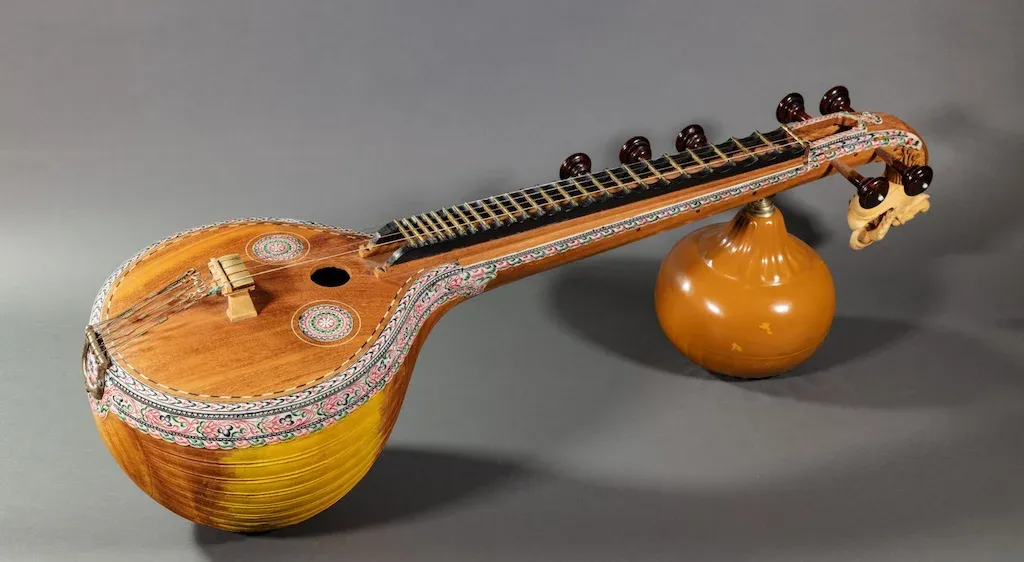The Ethereal Veena

The Veena stands as a quintessential symbol within the realm of Indian classical music, holding a revered position as one of the oldest and most revered musical instruments in the world. Its delicate strings and resonating body encapsulate the essence of Indian musical traditions, portraying a rich cultural heritage that spans centuries. This exploration aims to unravel the historical evolution and cultural eminence of the Veena, shedding light on its transformation through time and its pivotal role in shaping the landscape of classical music in India.
Origins of the Veena
The origins of the Veena can be traced back to the depths of ancient Indian scriptures and mythological narratives. Its genesis finds mention in revered texts such as the Vedas and the epics of Ramayana and Mahabharata, where celestial beings and divine entities are often depicted playing celestial instruments akin to the Veena.
The historical evolution of the Veena spans several millennia, mirroring the societal and cultural transformations of ancient India. Initially known as the ‘Vipanchi Veena’ or the ‘Kinnari Veena,’ it has undergone gradual modifications in its structure and playing techniques across different eras and regions.
Beyond its musical prowess, the Veena embodies profound cultural and religious symbolism. In Hindu mythology, it is often associated with the goddess Saraswati, the deity of knowledge, music, and art. The Veena in the hands of Saraswati symbolizes the harmonious blending of art and wisdom, signifying the pursuit of knowledge through the medium of music.
Types of Veena
The Veena, with its regional diversity, manifests in various forms across India. Notably, the Saraswati Veena in the South, the Rudra Veena in the North, and other regional variations showcase distinct structures and playing techniques, reflecting the cultural nuances of their respective regions:
Saraswati Veena: Predominantly prevalent in South India, the Saraswati Veena is characterized by its resonating body, curved frets, and delicate strings. Its elegant design and intricate craftsmanship symbolize the grace and aesthetic finesse associated with Carnatic music.
Rudra Veena: Hailing from the northern regions, the Rudra Veena boasts a robust structure, with a larger resonator and fewer frets. Known for its deep, resonant tones, this Veena embodies the meditative and contemplative essence found in Hindustani classical music.
The differences in geographical landscapes and cultural practices have significantly influenced the design and construction of each Veena type. Factors such as the choice of materials, playing techniques, and the musical repertoire associated with these Veena types further accentuate their regional identities.
The Saraswati Veena, with its delicate fretwork and melodic grace, reflects the serenity and sophistication of the Carnatic musical tradition. On the other hand, the robustness and resonance of the Rudra Veena capture the introspective and emotive essence of Hindustani classical music.
Playing Techniques and Musical Significance
Saraswati Veena Techniques: Players employ intricate fingering techniques, utilizing all fingers to produce melodic sequences known as ‘gamakas’ and ‘slides.’ The use of the ‘mizrab’ or plectrum enhances the Veena’s resonance, allowing for fluid and expressive playing.
Rudra Veena Techniques: With a focus on ‘meend’ (glissando) and ‘kan swar’ (microtones), Rudra Veena players evoke deep and resonant tones. The intricate use of the left hand on the frets and right-hand techniques contribute to the instrument’s emotive capabilities.
The Veena, whether Saraswati or Rudra, holds a pivotal position in classical music ensembles. It serves as both a solo and accompanying instrument, providing a harmonic and melodic foundation for vocalists and other instrumentalists. Its ability to evoke a vast array of emotions and ragas makes it an indispensable component of classical music performances.
The Veena’s versatility lies in its capacity to articulate the nuances of various ragas and musical motifs. Its melodic range, from the serene to the deeply contemplative, enables musicians to convey intricate emotions and evoke diverse moods within a performance. Moreover, the Veena’s ability to replicate the nuances of vocal music sets it apart as an instrument capable of transcending its strings to emulate the human voice.
Notable Veena Maestros and Contributions
Saraswati Veena Maestros: Highlighting eminent figures such as Veena Dhanammal, Emani Sankara Sastry, and Chitti Babu, whose virtuosity and innovation have left an indelible mark on Carnatic music. Their unique styles and contributions have expanded the repertoire and technique of the Saraswati Veena.
Rudra Veena Maestros: Celebrating luminaries like Asad Ali Khan, Zia Mohiuddin Dagar, and Bahauddin Dagar, whose mastery of the Rudra Veena revived and enriched the tradition of Dhrupad music in the Hindustani classical sphere.
These maestros not only showcased exceptional technical prowess but also contributed significantly to the evolution of Veena playing techniques and repertoire. Their innovative approaches, distinctive styles, and deep understanding of ragas expanded the horizons of classical music, elevating the status of the Veena as a solo instrument of profound artistic expression.
The compositions and improvisations by these maestros continue to resonate within classical music circles. Their renditions, compositions, and adaptations have enriched the classical repertoire, with intricate compositions showcasing the instrument’s capabilities and pushing the boundaries of traditional musical norms.
Beyond Music
The Veena’s significance transcends the confines of music, influencing various artistic expressions. Its depiction in paintings, sculptures, and literary works serves as a testament to its cultural prominence. References to the Veena in ancient texts, poetry, and epics highlight its revered status in Indian cultural heritage.
The Veena assumes a symbolic role in religious rituals, festivals, and ceremonies. Its association with the goddess Saraswati marks its presence during auspicious occasions, educational ceremonies, and worship rituals. The Veena’s presence signifies the embodiment of knowledge, art, and spirituality.
Beyond its individuality as a musical instrument, the Veena embodies the essence of India’s cultural identity. It serves as a cultural ambassador, reflecting the depth of Indian classical traditions, spirituality, and aesthetic values. The Veena’s presence in cultural narratives and societal customs underscores its integral role in shaping cultural consciousness.





